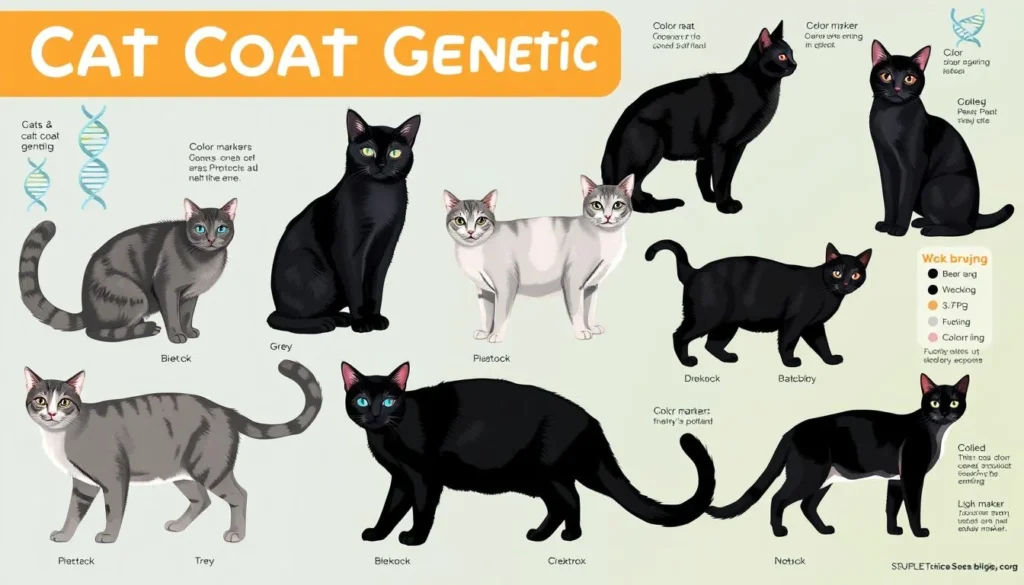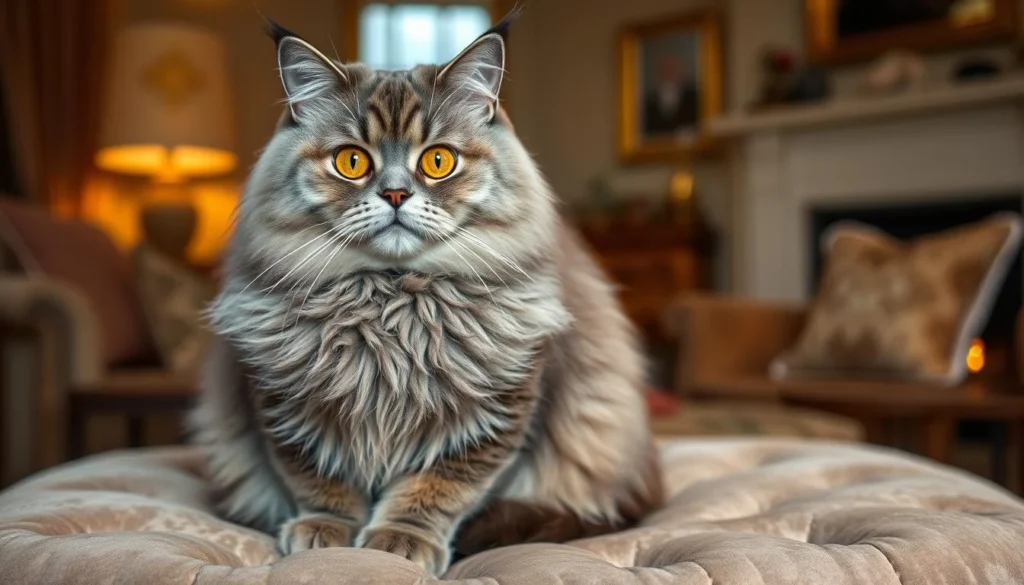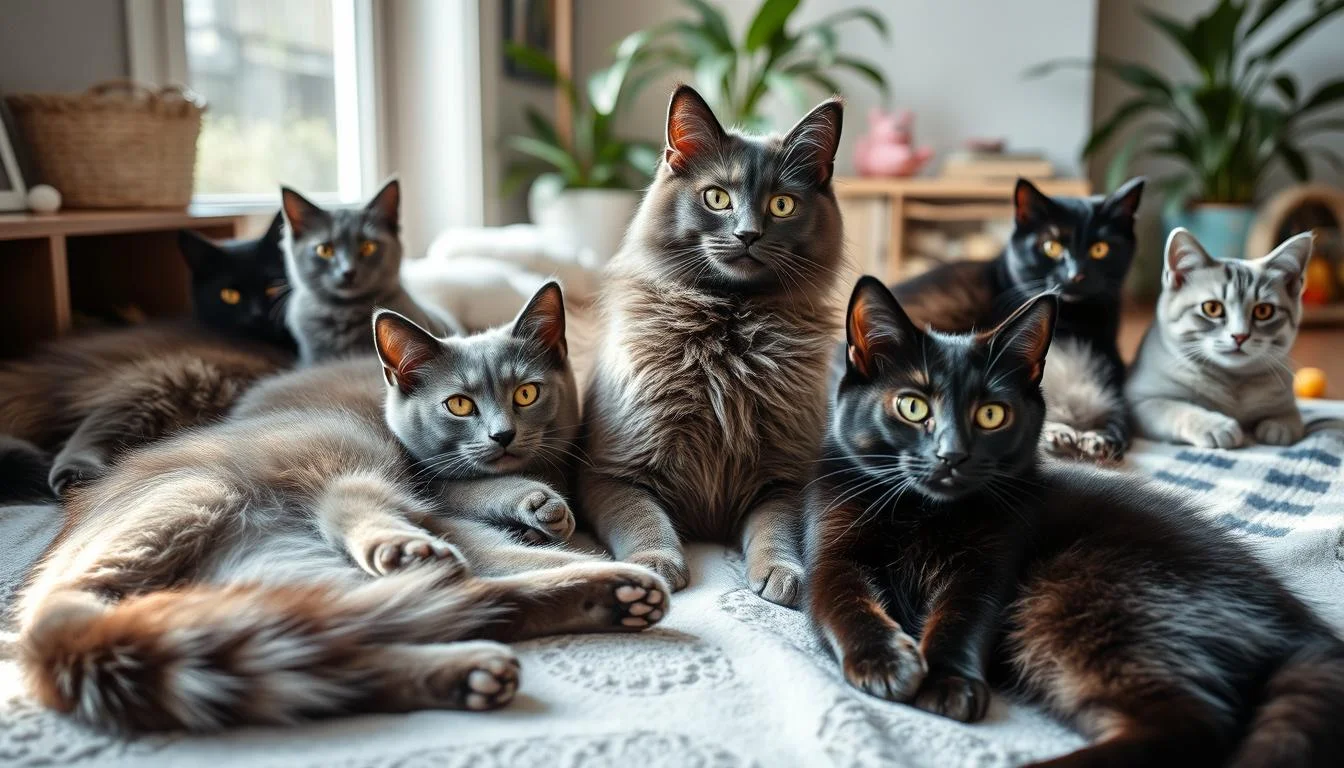Table of Contents
I’ve always been drawn to grey and black cats. They’re not just pretty; they’re like living art with hearts of gold. Each breed has its own tale, ready to join your family.
Black and grey cats are more than their colors. They bring elegance, mystery, and friendship. From the sleek Bombay to the soft British Shorthair, they come in a variety of personalities and looks.
In this guide, we’ll explore the top grey and black cat breeds loved by many. Whether you’re new to cats or a seasoned fan, these breeds will amaze and delight you.
Key Takeaways
- Grey and black cats offer unique personalities beyond their stunning coat colors
- Some breeds are more low-maintenance and family-friendly than others
- Coat color can influence adoption rates and shelter experiences
- Each breed has distinctive genetic and physical characteristics
- Understanding breed traits helps in selecting the perfect feline companion
Understanding Grey and Black Cat Genetics and Popularity
The world of cat breeds is full of complex genetics. These genetics shape the stunning coat colors of domestic cats. The journey of how these colors come to be is both fascinating and complex.

The Science Behind Coat Colors
Cat coat colors come from amazing genetic mechanisms. Cats are mainly black or orange, with other colors being variations of these.
- The agouti gene creates distinctive tabby patterns
- Melanin determines the intensity of coat color
- Recessive genes play a key role in unique coat variations
Common Misconceptions About Dark-Colored Cats
“Black cats are not unlucky – they’re simply misunderstood genetic marvels.” – Feline Genetics Research Team
Many myths surround dark-colored cats, like black cats. While some think they’re unlucky, others see them as lucky.
| Misconception | Scientific Reality |
|---|---|
| Black cats bring bad luck | Genetic variation, no correlation with luck |
| Dark cats are more aggressive | Coat color does not determine temperament |
Popularity Trends in Cat Colors
Choosing a cat breed and color is influenced by many factors. Grey tabby patterns are very popular. Breeds like Maine Coon and American Shorthair show off these beautiful patterns.
About 90-95% of cats in the U.S. are Domestic Shorthairs. This shows the wide range of feline coat colors and patterns.
The Majestic British Shorthair: A Classic Grey Beauty

Looking for a grey and black cat with a beautiful personality? The British Shorthair is a true marvel. These cats have won the hearts of many with their unique looks and charming nature.
“The British Shorthair is not just a cat, but a living piece of feline history.” – Cat Breed Enthuasiast
This breed comes from Britain’s streets, with a history going back to Roman times. Their strong build and soft coat make them stand out as one of the most recognizable grey cat breeds.
- Distinctive round face
- Dense, luxurious coat
- Calm and easygoing personality
- Excellent family companion
British Shorthairs show a great mix of independence and love. They love quiet time but also enjoy being with their family. This makes them great for many homes.
| Characteristic | Details |
|---|---|
| Life Span | 12-17 years |
| Weight Range | 3.0 – 7.7 kg |
| Family Friendliness | 3/5 |
| Grooming Needs | 3/5 |
Looking after a British Shorthair means knowing their special needs. Regular brushing, good food, and yearly vet visits will keep them healthy and joyful.
The Sleek Bombay: The Perfect Black Companion
Explore the world of Bombay cats, known as the “mini panthers” of domestic cats. These cats have stunning looks and a wonderful personality that will win your heart.
Bombay cats come from the United States. They are a unique breed that shows elegance and friendship. They stand out in cat care with their special looks and loving nature.
Physical Characteristics
Bombay cats have an impressive look that makes them different from other cats. Their main features are:
- Sleek, jet-black coat that looks like patent leather
- Muscular build with a medium-sized body
- Striking golden or copper-colored eyes
- Height ranging from 8-10 inches
- Adult weight between 6-11 pounds
Personality Traits
Intelligent and affectionate barely starts to describe the Bombay cat’s personality. These cats are known for being:
- 90% affectionate
- Dog-like in their devotion to their human family
- Highly sociable (90% rating)
- Exceptionally intelligent (90% rating)
- Playful (90% rating)
Care Requirements
Taking care of a Bombay cat means knowing their specific needs. Their easy-to-maintain coat and high social needs make them great companions for many homes.
- Occasional brushing (low grooming needs)
- Regular interactive playtime
- Annual veterinary check-ups
- Balanced diet tailored to their activity level
“The Bombay cat is not just a pet, but a loyal companion that brings joy and excitement to any home.” – Feline Experts
Bombay cats live for 12-16 years, making them long-term friends. Owners should know about health issues like respiratory problems and heart disease. Regular vet visits are key.
Grey and Black Cat Breeds in Modern Households
Choosing the right cat breed for your home is key. Grey and black domestic cats are popular for their adaptability and looks. They fit well in modern homes.
When picking a cat breed, think about several things. These cats are great for many homes because they:
- Adapt to different home environments
- Need little care for their coats
- Look great with your home decor
- Get along well with families and pets
Grey and black cat breeds are very versatile. They fit well into different home situations. They are also very social and can easily join family life.
| Cat Breed | Height Range | Weight Range | Lifespan |
|---|---|---|---|
| Bombay | 9-13 inches | 6-11 pounds | 12-16 years |
| British Shorthair | 12-14 inches | 9-17 pounds | 12-16 years |
| American Shorthair | 9-11 inches | 8-12 pounds | 15-20 years |
“The right cat doesn’t just live in your home—they become an integral part of your family’s story.” – Feline Experts Association
Choosing a grey or black cat breed should match your lifestyle. Think about their energy, grooming needs, and how they get along with others. This ensures they fit perfectly into your home.
Russian Blue: The Silver-Coated Aristocrat
Explore the world of the Russian Blue, a stunning grey and black cat breed. This elegant feline adds a touch of aristocratic charm to any home. It combines beauty with a unique personality that cat lovers cherish.
The Russian Blue is known for its silvery-blue coat and captivating emerald green eyes. These cats are more than just beautiful. They are intelligent, gentle companions that can make your home special.
Distinctive Features
- Plush double coat with a silvery-blue sheen
- Striking emerald green eyes
- Slender, muscular body type
- Medium-sized breed with elegant proportions
Temperament and Behavior
Russian Blues are known for their reserved yet affectionate nature. They form deep bonds with their family but can be shy around strangers. Your Russian Blue will likely be:
- Intelligent and observant
- Gentle and calm
- Loyal to their chosen humans
- Quiet and well-behaved
Health Considerations
| Health Aspect | Specific Considerations |
|---|---|
| Weight Management | Prone to obesity – requires careful diet monitoring |
| Regular Check-ups | Annual veterinary visits recommended |
| Coat Care | Low-shedding, relatively easy grooming |
When it comes to cat care, the Russian Blue needs moderate attention. Their hypoallergenic coat and gentle disposition make them a great choice for families. They seek a sophisticated feline companion.
“The Russian Blue is not just a pet, but a refined companion with a heart of gold.” – Feline Breed Experts
The American Shorthair: Versatile and Charming
The American Shorthair is a unique domestic cat with a long history. They come from cats that sailed on the Mayflower. Today, they are loved pets across the United States. Their adaptability makes them a great choice for many.
These cats have some amazing traits:
- Muscular and well-proportioned body
- Short, dense coat in multiple colors and patterns
- Exceptional hunting instincts
- Friendly and sociable temperament
“An American Shorthair is not just a pet, but a piece of living American history.”
They are truly impressive. They are 8 to 10 inches tall and weigh 10 to 15 pounds. They live 15 to 20 years, making them great family pets.
| Characteristic | Details |
|---|---|
| Energy Level | Active |
| Coat Length | Short |
| Common Patterns | Brown and Silver Tabby |
| Eye Colors | Green, Blue, Copper, Gold, Hazel |
If you want a reliable and adaptable feline companion, the American Shorthair is perfect. They are playful and social, fitting well into many homes.
Keep in mind, they have a strong prey drive. They need regular play. Experts suggest at least two 10-15 minute play sessions a day to keep them happy and healthy.
Essential Care Tips for Dark-Coated Cats
Caring for grey and black cats needs special attention. This is to keep their stunning coat and health in top shape. Dark-coated cats have unique needs that go beyond the usual cat care.
Dark-coated cats face special challenges that need dedicated care. Knowing their grooming, nutrition, and health monitoring needs is key. This helps keep your feline friend looking and feeling great.
Specialized Grooming Requirements
Grooming dark-coated cats is more than just regular brushing. Black cats are more likely to see coat changes, mainly when they get sunlight.
- Brush your cat weekly to reduce shedding and distribute natural oils
- Use a soft-bristled brush to prevent damaging the delicate fur
- Check for signs of cat rust – a reddish-brown color change in black fur
- Limit direct sun exposure to prevent pigment bleaching
Nutrition for Coat Health
Proper diet is key for your cat’s coat color and health. Certain nutrients are vital for preventing color changes and keeping fur quality high.
- Ensure diet is rich in protein and fatty acids
- Include tyrosine-rich foods to prevent nutritional deficiencies
- Consult your veterinarian about specialized nutrition for dark-coated cats
Health Monitoring Strategies
Monitoring feline behavior and health is critical for dark-coated cats. Some issues might be less visible due to their coat color. So, regular check-ups are a must.
- Perform weekly skin and coat inspections
- Watch for signs of color changes or unusual fur patterns
- Schedule regular veterinary check-ups
- Pay attention to changes in coat texture or color
“A well-cared-for cat is a happy cat, regardless of coat color.” – Veterinary Experts
By following these specialized care tips, you can ensure your dark-coated cat stays healthy, vibrant, and stunning.
Common Health Concerns in Grey and Black Cats
Understanding health issues is key for cat care. Grey and black cats face many health challenges. They need careful attention and proactive care.
Skin conditions are common in cats. Here are some important facts:
- Feline acne affects about 5% of cats, mainly on the chin.
- Bacterial skin infections make up 30-50% of all feline skin problems.
- Ringworm affects around 10% of cats, mostly the younger ones.
- Allergic dermatitis impacts 10-15% of cats, causing a lot of discomfort.
Parasitic challenges are also a big concern. About 20% of cats face skin conditions due to parasites. This includes:
- Flea infestations (affecting up to 15% of cats).
- Ear mites (affecting about 5% of cats).
- Lice infestations (occurring in about 3% of feline populations).
“Prevention and early detection are key to maintaining your cat’s health and quality of life.”
Regular vet visits are important. They help catch health issues early. For grey and black cats, a balanced diet, less stress, and preventative care are vital.
Look out for signs like persistent scratching, coat changes, or unusual skin lesions. These could mean serious health problems that need vet attention.
Choosing Between Different Dark-Coated Breeds
Choosing the right dark-colored cat breed is important. It depends on your lifestyle and home. Each cat breed, like those with grey and black coats, has its own traits. These traits can affect how well they fit into your home.
Knowing the differences between cat breeds is key. It helps you choose a cat that makes you happy and keeps them healthy.
Living Space Considerations
Different dark-coated cat breeds need different amounts of space. You should think about:
- Apartment-friendly breeds
- Cats that need to go outside
- Space for play and exercise
Family Compatibility
Family dynamics are important when picking a cat breed. A survey showed interesting facts about cat colors and personalities:
| Cat Color | Personality Perception |
|---|---|
| Black Cats | Less extreme behavior, adaptable |
| Orange/Bi-colored Cats | Friendly and sociable |
| White Cats | Shy, calm, lazy |
Activity Level Requirements
Energy levels differ among cat breeds. Some dark-coated cats are calm, while others need lots of play and mental challenges.
“The right cat breed can transform your home into a harmonious living space.”
By considering these factors, you can find a dark-coated cat that fits your lifestyle. They will bring joy and companionship to your home.
The Cultural Impact of Dark-Colored Cats
Dark-colored cats have a deep cultural impact. They have been seen as both good and bad in history. This shows how complex their meanings are across cultures.
The world of feline behavior is full of interesting cultural views. Let’s look at some amazing beliefs about dark-colored cats:
- In Japan, black cats are seen as lucky charms for finding love
- European sailors thought black cats meant safe sea trips
- Scottish traditions say a black cat at the door means wealth is coming
- French folklore believes a black cat’s visit signals magic
Despite their importance, black cats struggle in today’s world. Shocking numbers show they are the least adopted cat color. Only 10% find homes, and 74.6% are euthanized in shelters.
“Black cats are not bad luck—they’re simply misunderstood companions waiting for their chance to shine.” – Anonymous Cat Lover
Old superstitions have hurt dark-colored cats’ image. In the Middle Ages, they were linked to witchcraft, leading to persecution. The Catholic Church’s “Vox in Rama” document in the 13th century made things worse, causing many black cats to be killed.
Now, animal lovers are fighting to change these bad views. Knowing their cultural history can help us see them in a new light. It’s time to appreciate these amazing cats for who they truly are.
Conclusion
Exploring grey and black cat breeds is more than just looking at their color. Personality traits vary across breeds, influenced by genetics. Your ideal cat is about understanding their unique qualities, not just their looks.
Each grey and black cat breed brings something special to your home. From the majestic Russian Blue to the sleek Bombay, there’s a wide range to choose from. Research shows coat color can affect personality, so choose wisely based on temperament and lifestyle.
When picking your grey and black cat, know their specific needs. Think about their energy, grooming, and health. Black cats, for example, might be less prone to some health issues. With the right knowledge, you’ll bond with a remarkable companion.
The right cat breeds will add joy and companionship to your life. Whether you prefer the elegant British Shorthair or the playful American Shorthair, your perfect cat is out there. They’ll become a beloved part of your family.
